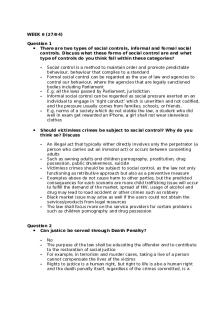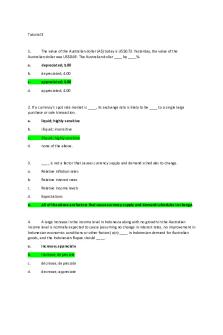Writing tutorial Chp 3 PDF

| Title | Writing tutorial Chp 3 |
|---|---|
| Author | Jessie Huixian |
| Course | Security Investment and Portfolio Management |
| Institution | Universiti Sains Malaysia |
| Pages | 3 |
| File Size | 143.4 KB |
| File Type | |
| Total Downloads | 110 |
| Total Views | 149 |
Summary
Download Writing tutorial Chp 3 PDF
Description
L01) 14) DRK, Inc., has just sold 100,000 shares in an initial public offering. The underwriter's explicit fees were $60,000. The offering price for the shares was $40, but immediately upon issue, the share price jumped to $44. a. What is the total cost to DRK of the equity issue? a. In addition to the explicit fees of $60,000, we should also take into account the implicit cost incurred to DRK from the underpricing in the IPO. The underpricing is $4 per share, or a total of $400,000, implying total costs of $460,000. b. Is the entire cost of the underwriting a source of profit to the underwriters? b. No. The underwriters do not capture the part of the costs corresponding to the underpricing. However, the underpricing may be a rational marketing strategy to attract and retain long-term relationships with their investors. Without it, the underwriters would need to spend more resources in order to place the issue with the public. The underwriters would then need to charge higher explicit fees to the issuing firm. The issuing firm may be just as well off paying the implicit issuance cost represented by the underpricing.
L02) 21) Here is some price information on Fincorp stock. Suppose first that Fincorp trades in a dealer market. Bid Asked 55.25 55.50 a. Suppose you have submitted an order to your broker to buy at market. At what price will your trade be executed? (Round your answer to 2 decimal places.) A 55.25 b. Suppose you have submitted an order to sell at market. At what price will your trade be executed? (Round your answer to 2 decimal places.) B 55.50 c. What will happen suppose you have submitted a limit order to sell at $55.62. Trade will be executed. Trade will not be executed. B Trade will not be executed d. What will happen suppose you have submitted a limit order to buy at $55.37. Trade will not be executed. Trade will be executed. A Trade will be executed
L03) 17) Consider the following limit order book for a share of stock. The last trade in the stock occurred at a price of $50. (LO 3-3) Limit Buy Orders Limit Sell Orders Price Shares $49.75. 500 49.70 900 49.65 700 49.60 400 48.65 600
Price Shares. $49.80 100 49.85 100 49.90 300 49.95 100
a. If a market buy order for 100 shares comes in, at what price will it be filled? a. The market-buy order will be filled at $49.80, the best price of limit-sell orders in the book. b. At what price would the next market buy order be filled? b. The next market-buy order will be filled at $49.85, the next-best limit-sell order price. c. If you were a security dealer, would you want to increase or decrease your inventory of this stock? c. As a security dealer, you would want to increase your inventory. There is considerable buying demand at prices just below $50, indicating that downside risk is limited. In contrast, limit-sell orders are sparse, indicating that a moderate buy order could result in a substantial price increase.
L04) 22) You've borrowed $20,000 on margin to buy shares in Ixnay, which is now selling at $40 per share. Your account starts at the initial margin requirement of 50%. The maintenance margin is 35%. Two days later, the stock price falls to $35 per share. a) Will you receive a margin call? a. You will not receive a margin call. You borrowed $20,000 and with another $20,000 of your own equity you bought 1,000 shares of Ixnay at $40 per share. At $35 per share, the market value of the stock is $35,000, your equity is $15,000, and the percentage margin is: $15,000/$35,000 = 42.9% Your percentage margin exceeds the required maintenance margin. b) How low can the price of Ixnay shares fall before you receive a margin call? b. You will receive a margin call when: (1000P - $20,000)/1000P = 0.35 --> when P = $30.77 or lower
23) On January 1, you sold short one round lot (that is, 100 shares) of Lowe's stock at $21 per share. On March 1, a dividend of $3 per share was paid. On April 1, you covered the short sale by buying the stock at a price of $15 per share. You paid 50 cents per share in commissions for each transaction. a. What is the proceeds from the short sale (net of commission)? a. The proceeds from the short sale (net of commission) were: ($21 × 100) - $50 = $2,050. b. What is the dividend payment? b. 100 shares x $3 a share = $300 c. What is the total cost, including commission, if you have to cover the short sale by buying the stock at a price of $15 per share? c. A dividend payment of $300 was withdrawn from the account. Covering the short sale at $15 per share costs (including commission): $1,500 + $50 = $1,550 d. What is the net gain from your transaction? d. Therefore, the value of your account is equal to the net profit on the transaction: $2,050 - $300 - $1,550 = $200...
Similar Free PDFs

Writing tutorial Chp 3
- 3 Pages

Writing 3
- 1 Pages

Tutorial 1 Essay Writing Tips
- 35 Pages

Handmaid\'s Tale Chp 3-19
- 7 Pages

Multiple Choice Questions CHp 3
- 11 Pages

ART 201 Chp 3 Notes
- 13 Pages

Tutorial 3
- 3 Pages

Tutorial 3
- 4 Pages

Tutorial 3
- 4 Pages

Tutorial 3
- 12 Pages

3 - tutorial
- 6 Pages

Tutorial 3
- 6 Pages

Tutorial 3
- 4 Pages

3 academic writing
- 32 Pages
Popular Institutions
- Tinajero National High School - Annex
- Politeknik Caltex Riau
- Yokohama City University
- SGT University
- University of Al-Qadisiyah
- Divine Word College of Vigan
- Techniek College Rotterdam
- Universidade de Santiago
- Universiti Teknologi MARA Cawangan Johor Kampus Pasir Gudang
- Poltekkes Kemenkes Yogyakarta
- Baguio City National High School
- Colegio san marcos
- preparatoria uno
- Centro de Bachillerato Tecnológico Industrial y de Servicios No. 107
- Dalian Maritime University
- Quang Trung Secondary School
- Colegio Tecnológico en Informática
- Corporación Regional de Educación Superior
- Grupo CEDVA
- Dar Al Uloom University
- Centro de Estudios Preuniversitarios de la Universidad Nacional de Ingeniería
- 上智大学
- Aakash International School, Nuna Majara
- San Felipe Neri Catholic School
- Kang Chiao International School - New Taipei City
- Misamis Occidental National High School
- Institución Educativa Escuela Normal Juan Ladrilleros
- Kolehiyo ng Pantukan
- Batanes State College
- Instituto Continental
- Sekolah Menengah Kejuruan Kesehatan Kaltara (Tarakan)
- Colegio de La Inmaculada Concepcion - Cebu

